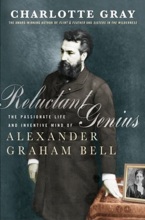
This is the story of a Genius At Home. There are lots of books about Alexander Graham Bell and the discovery of the telephone. What Charlotte Gray has done is tell the story of this inventor and his equally inventive wife, who was herself deaf, but successful in making their home work.
Alexander Graham Bell was born in Edinburgh in l847, at a time when the Scottish Enlightenment was bursting with ideas in science,medicine, philosophy and the arts. Both Bell’s grandfather and father had worked in speech therapy. His mother was deaf. His father studied phonetics and encouraged his son in his hands-on experiments after school. Alec taught at a school for the Deaf in London. Double tragedy struck when both his brothers died of TB. His father moved the family to Brantford,Ontario. Here Alec turned frantically to experimenting with vibrations created by human speech. Morse’s electro-magnetic telegraphs had been in use for 25 years. The race was on to find a harmonic telegraph that would use sympathetic vibration to send several messges on a single wire simultaneously. Bell got a job in Boston, at the School of Oratory, Boston University.
One day he met a newly-enrolled deaf student, Mabel Hubbard. Bright and confident, she was the daughter of prominent Boston lawyer who was also President of the Clarke Institute for Deaf Mutes. By reading lips, Mabel had always functioned in the speaking world.She had no trouble relating to the young professor but was baffled by his dishevelled appearance and rough, impatient manner. Alec was fascinated by her gentle beauty, and driven to work day and night.
At home in Brantford, he hit on the key to creating an electric current to carry sound along a telegraph wire. The telephone was born. Back in Boston, Gray describes the struggle in which Mabel’s father, an astute entrepreneur, saw the possibilities in the young professor’s ideas, but also wanted to protect his beloved daughter. He helped Bell get the patent for his invention, before he agreed to Mabel marrying him. The rest is history…both Bells and Hubbards had made their fortune.
Gray then sketches in a marriage with huge potential difficulties, but bound by great affecion on both sides. Mabel learned to handle her husband’s periods of desperate energy when he would work until exhaustion made him sick. The consideration went both ways. Alec at all times included his wife in everything he did, reading her lips, never assigning her to the side-lines with sign language only. They had two daughters (and later two sons who died prematurely). In New York, and later Washington, Bell became a celebrity, sought after by people like Helen Keller. Mabel had a hard time getting him away from his work. With his father-in-law he backed two publications,SCIENCE, and the NATIONAL GEOGRAPHIC.
In l889, Bell travelled to Nova Scotia and found a spot in Cape Breton that stole his heart. His home, Beinn Bhreagh, was on the Bras d’Or Lake near Baddeck. It became a haven for his family for the rest of their lives. The daughters married happily and Bell became a devoted grandfather. He spent more and more time there and built a complete research laboratory. A wide range of experiments included a huge tetrahedral kite, and the JUNE BUG, the first flying machine to fly one kilometre in a public demonstration. In l9l5, Bell agreed to speak on the first transcontinental call at the New York headquarters of the American Telephone and Telegraphy Company.
On August 4,l922, Bell died at Baddeck. His wife developed terminal cancer and died five months later. Gray tells us in her Epilogue that she visited the Bell National Historic Site in l997 and immediately resolved to write about both Alexander Graham Bell and his wife. She does so with skill and grace. Born in England, Gray has lived in Ottawa for many years and published a number of successful biographies. In this one her voice is transatlantic – much as Bell’s was – and it works very well. It might have been better if she had told us up front what she intended to do, but it is well worth the deliberate pace by which she brings these remarkable people to life.
Thanks to Anne for the review!